A Sustainable Approach for the Refurbishment Process of Vernacular Heritage: The Sesga House Case Study (Valencia, Spain)
Abstract
:1. Introduction
2. Materials and Methods
2.1. Case Study Description
2.2. Criteria Used for Decision Making
- Historic finishes have been respected. Any existing bare rough stone or stone slab walls have been maintained and any existing gaps have been jointed.
- Interior gypsum-rendered walls have been re-rendered after adding thermal insulation and new walls. Extremely fast-setting gypsum was used as rendering, following tradition and leaving the natural marks of the trowel.
- Flooring had a waxed gypsum rendering, recovering an almost-extinct local tradition.
- Double-glazed wooden windows were added where previously there had only been wooden shutters.
- The inner doors of the dwelling are small historic doors which have been repaired, including a charm against evil spirits in the form of three candle burn marks. The low doors make it necessary to duck when entering the room, as if revering the history of the space.
2.3. Evaluation Tools Used for Sustainability Integration in the Design Process of a Building Refurbishment Projects
2.3.1. VerSus Methodology and SDGs
2.3.2. Life Cycle Assessment Integration in the Design Process of a Refurbishment
Options Assessed
- Option (1) a refurbished building with natural materials, defined as those materials that wholly or partly are derived from biomass, such as plants, trees or animals [57] (e.g., wood, reed, gypsum, cork, earth, lime, etc.)
- Option (2) a refurbished building with conventional industrial materials, defined as those materials that are the most representative and often used currently on a site (e.g., bricks, concrete, steel, polystyrene, etc.)
- Option (3) the new building construction with conventional industrial materials together with the complete demolition of the existing building.
Goal, Scope and System Boundaries Definition
Life Cycle Inventory
- For modelling the transports, regardless the type of material a unique dataset was considered, “transport, lorry 16t”, and the distances to the manufacturing points were estimated based on the real scenario.
- During the construction stages, the energy consumption of machinery and the impact of construction waste were considered (estimated as a 5% of the amount of each material).
- The calculation of the energy and fuel consumption was based on ecoinvent data v1.2.0 [60].
- The assumed end-of-life scenarios were 100% incineration for the natural materials and 100% landfill for the rest of building materials in all the assessed options.
- The distances to the landfill and incineration point for final disposal were 40 km.
Life Cycle Impact Assessment
3. Results
3.1. Application of Qualitative Criteria (versus Program and SDGs)
3.2. Application of Quantitative Criteria (LCA)
4. Discussion
Detected Challenges and Limitations
5. Conclusions
Supplementary Materials
Author Contributions
Funding
Institutional Review Board Statement
Informed Consent Statement
Data Availability Statement
Acknowledgments
Conflicts of Interest
References
- Von der Leyen, U. A Union That Strives for More. My Agenda for Europe. Available online: https://ec.europa.eu/info/strategy/priorities-2019-2024_es#documents (accessed on 3 June 2021).
- European Commission. Communication from the Commission to the European Parliament, the European Council, the Council, the European Economic and Social Committee and the Committee of the Regions, the European Green Deal, COM (2019), 640 Final; European Commission: Brussels, Belgium, 2019. [Google Scholar]
- Jensen, P.A.; Maslesa, E. Value based building renovation—A tool for decision-making and evaluation. Build. Environ. 2015, 92, 1–9. [Google Scholar] [CrossRef] [Green Version]
- European Commission. Commission Staff Working Document, Sustainable Products in a Circular Economy—Towards an EU Product Policy Framework Contributing to the Circular Economy, SWD (2019) 91 Final; European Commission: Brussels, Belgium, 2019. [Google Scholar]
- Council of Europe. Council of Europe Framework Convention on the Value of Cultural Heritage for Society. 2005. Available online: https://rm.coe.int/1680083746 (accessed on 5 June 2021).
- Ballester, J.M. Vernacular architecture in the modern concept of cultural heritage. In Vernacular Architecture: Towards a Sustainable Future; Taylor and Francis: London, UK, 2015; pp. 3–8. [Google Scholar]
- Oliver, P. Dwellings: The Vernacular House World Wide; Phaidon: New York, NY, USA, 2003. [Google Scholar]
- Oliver, P. Built to Meet Needs. Cultural Issues in Vernacular Architecture; Elsevier: Amsterdam, The Netherlands, 2006. [Google Scholar]
- Frey, P. Learning from Vernacular; Actes Sud.: Arles, France, 2010. [Google Scholar]
- Weber, W.; Yannas, S. (Eds.) Lessons from Vernacular Architecture; Routledge: Glasgow, UK, 2014. [Google Scholar]
- Vellinga, M. Vernacular architecture and sustainability: Two or three lessons… In Vernacular Architecture: Towards a Sustainable Future; Taylor and Francis: Boca Raton, FL, USA, 2015; pp. 3–8. [Google Scholar]
- Vellinga, M. The noble vernacular. J. Archit. 2013, 18, 570–590. [Google Scholar] [CrossRef]
- Neila, F.J. Miradas Bioclimáticas a la Arquitectura Popular del Mundo; García-Maroto Editores S.L.: Madrid, Spain, 2015. [Google Scholar]
- Neila, F.J. La Arquitectura Vernácula Más Sostenible; García-Maroto Editores S.L.: Madrid, Spain, 2017. [Google Scholar]
- Guillaud, H.; Moriset, S.; Sánchez, N.; Sevillano, E. (Eds.) Versus—Lessons from Vernacular Hetitage to Sustainable Architecture; CRAterre: Grenoble, France, 2014. [Google Scholar]
- Correia, M.; Dipasquale, L.; Mecca, S. (Eds.) Versus—Heritage for Tomorrow. Vernacular Knowledge for Sustainable Architecture; Florence University Press: Florence, Italy, 2014. [Google Scholar]
- Correia, M.; Carlos, G.; Rocha, S. (Eds.) Vernacular Heritage and Earthen Architecture. Contributions for Sustainable Development; CRC-Taylor & Francis Group: London, UK, 2014. [Google Scholar]
- Mileto, C.; Vegas, F.; García-Soriano, L.; Cristini, V. (Eds.) Vernacular Architecture: Towards a Sustainable Future; CRC-Taylor & Francis Group: London, UK, 2015. [Google Scholar]
- Mileto, C.; Vegas, F.; García-Soriano, L.; Cristini, V. (Eds.) Vernacular and Earthen Architecture: Conservation and Sustainability; CRC-Taylor & Francis Group: London, UK, 2018. [Google Scholar]
- Piesik, S. Habitat: Vernacular Architecture for a Changing Planet; Thames and Hudson: London, UK, 2017. [Google Scholar]
- Buyle, M.; Braet, J.; Audernaet, A. LCA in the construction industry: A review. Int. J. Energy Environ. 2012, 6, 397–405. [Google Scholar]
- Cabeza, L.F.; Rincón, L.; Vilariño, V.; Pérez, G.; Castell, A. Life cycle assessment (LCA) and life cycle energy analysis (LCEA) of buildings and the building sector: A review. Renew. Sustain. Energy Rev. 2014, 29, 394–416. [Google Scholar] [CrossRef]
- Gillott, M.; Spataru, C. Materials for energy efficiency and thermal comfort in the refurbishment of existing buildings. In Materials for Energy Efficiency and Thermal Comfort in Buildings; Woodhead Publishing Series in Energy; Elsevier: Amsterdam, The Netherlands, 2010; pp. 649–680. [Google Scholar]
- Earl, J. Building Conservation Philosophy; Donhead: London, UK, 2003. [Google Scholar]
- Hunt, R.; Suhr, M. Old Houses Handbook. A practical Guide to Care and Repair; SPAB: London, UK, 2008. [Google Scholar]
- Suhr, M.; Hunt, R. A Practical Guide to Retrofitting for Energy-Efficiency & Sustainability; SPAB: London, UK, 2013. [Google Scholar]
- Fatoric, S.; Biesbroek, R. Adapting cultural heritage to climate change impacts in The Netherlands: Barriers, interdependencies, and strategies for overcoming them. Clim. Chang. 2020, 162, 301–320. [Google Scholar] [CrossRef]
- Fatoric, S.; Egberts, L. Realising the potential of cultural heritage to achieve climate change actions in The Netherlands. J. Environ. Manag. 2020, 274, 111107. [Google Scholar] [CrossRef]
- Carroon, J. Sustainable Preservation: Greening Existing Buildings. Wiley Books: Hoboken, NJ, USA, 2010. [Google Scholar]
- Ferreira, J.; Duarte Pinheiro, M.; de Brito, J. Economic and environmental savings of structural buildings refurbishment with demolition and reconstruction—A Portuguese benchmarking. J. Build. Eng. 2015, 3, 114–126. [Google Scholar] [CrossRef]
- Adam, R. The greenest building is the one that already exists. Architects’ Journal, 24 September 2019. [Google Scholar]
- Gan, V.J.; Cheng, J.C.; Lo, I.M.; Chan, C.M. Developing a CO2-e accounting method for quantification and analysis of embodied carbon in high-rise buildings. J. Clean. Prod. 2017, 141, 825–836. [Google Scholar] [CrossRef]
- Kim, Y.-C.; Zhang, Y.-L.; Park, W.-J.; Cha, G.-W.; Kim, J.-W.; Hong, W.-H. Analysis of waste generation characteristics during new apartment construction—considering the construction phase. Int. J. Environ. Res. Public Health 2019, 16, 3485. [Google Scholar] [CrossRef] [PubMed] [Green Version]
- Akbarnezhad, A.; Xiao, J. Estimation and minimization of embodied carbon of buildings: A review. Buildings 2017, 7, 5. [Google Scholar] [CrossRef]
- Vilches, A.; Garcia-Martinez, A.; Sanchez-Montañes, B. Life cycle assessment (LCA) of building refurbishment: A literature review. Energy Build. 2017, 135, 286–301. [Google Scholar] [CrossRef]
- Pombo, O.; Rivela, B.; Neila, J. The challenge of sustainable building renovation: Assessment of current criteria and future outlook. J. Clean. Prod. 2016, 123, 88–100. [Google Scholar] [CrossRef]
- Kamari, A.; Jensen, S.R.; Corrao, R.; Kirkegaard, P.H. A holistic multi-methodology for sustainable renovation. Int. J. Strat. Prop. Manag. 2018, 23, 50–64. [Google Scholar] [CrossRef]
- Careccia, C.; D’Incognito, M. Life cycle assessment as a mean to grow awareness on the environmental impact of conservation. In Vernacular Architecture: Towards a Sustainable Future; Taylor and Francis: London, UK, 2015; pp. 185–191. [Google Scholar]
- Blanco, J.; Serrano, B.; Ortega, L.; Soto, L. Strategies for energy retrofitting of vernacular architecture of Cabanyal-Canyamelar. In Vernacular Architecture: Towards a Sustainable Future; Taylor and Francis: Boca Raton, FL, USA, 2015; pp. 737–740. [Google Scholar]
- Vegas, F.; Mileto, C. Km conservation. In Vernacular Architecture: Towards a Sustainable Future; Taylor and Francis: London, UK, 2015; pp. 737–740. [Google Scholar]
- Luxton, C.; Bevan, S. Restored to Glory. A Guide to Renovating Your Period Home; BBC Books: London, UK, 2005. [Google Scholar]
- Europa Nostra. Pilot Project for the Restoration of Vernacular Dwellings in Valencia. Available online: https://www.europeanheritageawards.eu/winners/pilot-project-restoration-vernacular-dwellings-valencia/ (accessed on 5 July 2021).
- Vegas, F.; Mileto, C. Traditional techniques in masonry buildings at Rincón de Ademuz (Valencia). In Proceedings of the 10th Canadian Masonry Symposium, Banff, AB, Canada, 8–12 June 2005; pp. 674–683. [Google Scholar]
- Lončar, S.; Vellinga, M. Rural regeneration. In Architectural Regeneration; Wiley Blackwell: Hoboken, NJ, USA.
- United Nations Development Programme. The SGDS in Action. Available online: https://www.undp.org/publications/sdgs-action (accessed on 10 July 2021).
- Vegas, F.; Mileto, C.; Diodato, M.; Soriano, J.G.; Giménez, C.G. Traditional structures made with gypsum pillars: A reasoned hypothesis. In Proceedings of the 4th International Congress on Construction History, Paris, France, 3–7 July 2012; Volume II, pp. 509–516. [Google Scholar]
- Vegas, F.; Mileto, C.; Ivorra, S.; Baeza, F.J. Checking gypsum as structural material. Appl. Mech. Mater. 2011, 117–119, 1576–1579. [Google Scholar] [CrossRef]
- Diodato, M. Estudio dendrocronológico de la casa n. 119 del Catastro de la aldea de Sesga; Universitat Politècnica de Valencia: Valencia, Spain, 2012; Unpublished Study. [Google Scholar]
- Pastor, P. Interview with Primitivo Pastor, former inhabitant of the house. 20 June 2007.
- Vegas, F.; Mileto, C. Cultural identity & built landscape. Pilot project for the restoration of traditional houses in Rincón de Ademuz (Valencia). Loggia Arquit. Restauración 2005, 17, 90–105. [Google Scholar]
- Vegas, F.; Mileto, C.; Cristini, V.; Ruiz, J.R.; La Spina, V. Gypsum as reinforcement for floors: Conceptual approach. In Vernacular Heritage and Earthen Architecture; CRC Press: London, UK, 2014; pp. 389–394. [Google Scholar]
- ISO (International Organization for Standardization). ISO 14040:2006 Environmental Management—Life Cycle Assessment—Principles and Framework; International Organization for Standardization: Geneva, Switzerland, 2006. [Google Scholar]
- ISO (International Organization for Standardization). ISO 14044:2006 Environmental Management—Life Cycle Assessment—Requirements and Guidelines; International Organization for Standardization: Geneva, Switzerland, 2006. [Google Scholar]
- CEN (European Committee for Standardization). EN, EN 15978:2011—Sustainability of Construction Works—Assessment of Environmental Performance of Buildings—Calculation Method, Int. Stand; European Committee for Standardization: Brussels, Belgium, 2011. [Google Scholar]
- CEN (European Committee for Standardization). EN, N 15804:2012 + A2:2019—Sustainability of Construction Works—Environmental Product Declarations—Core Rules for the Product Category of Construction Products, Int. Stand.; European Committee for Standardization: Brussels, Belgium, 2012. [Google Scholar]
- CTE (Technical Building Code). Spanish Building Technical Code, Real Decreto 314/2006 17 Marzo, BOE 74; CTE (Technical Building Code): Madird, Spain, 2006; pp. 11816–11831. [Google Scholar]
- CEN (European Committee for Standardization). EN 16575:2014-10 Bio-Based Products—Vocabulary; European Committee for Standardization: Brussels, Belgium, 2014. [Google Scholar]
- Frey, P.; Dunn, L.; Cochran, R.; Spataro, K.; McLennan, J.F.; DiNola, R.; Heider, B. The Greenest Building: Quantifying the Environmental Value of Building Reuse. 2016. Available online: www.cascadiagbc.org (accessed on 24 May 2021).
- Hasik, V.; Escott, E.; Bates, R.; Carlisle, S.; Faircloth, B.; Bilec, M.M. Comparative whole-building life cycle assessment of renovation and new construction. Build. Environ. 2019, 161, 106218. [Google Scholar] [CrossRef]
- Ecoinvent Database. Available online: https://www.ecoinvent.org (accessed on 24 May 2021).
- Guinée, J.B.; Gorrée, M.; Heijungs, R.; Huppes, G.; Klejn, R.; de Koning, A.; van Oers, L.; Wegener Sleeswijk, A.; Suh, S.; Udo de Haes, H.A.; et al. Life Cycle Assessment—An Operational Guide to the ISO Standards—Parts 1, 2 and 3; Ministry of Housing, Spatial Planning and the Environment: Hague, The Netherlands, 2001. [Google Scholar]
- Hoxha, E.; Passer, A.; Ruschi, M.; Mendes, M.; Saade, M.; Trigaux, D.; Shuttleworth, A.; Pittau, F.; Allacker, K.; Habert, G. Biogenic carbon in buildings: A critical overview of LCA methods. Build. Cities 2020, 1, 504–524. [Google Scholar] [CrossRef]
- CEN (European Committee for Standardization). EN 16449 Wood and Wood-Based Products—Calculation of the Biogenic Carbon Content of Wood and Conversion to Carbon Dioxide; European Committee for Standardization: Brussels, Belgium, 2014. [Google Scholar]
- Garcia, R.; Freire, F. Carbon footprint of particleboard: A comparison between ISO/TS 14067, GHG Protocol, PAS 2050 and Climate Declaration. J. Clean. Prod. 2014. [Google Scholar] [CrossRef]
- Tomás Márquez, S. Análisis comparado de la estructura interna del presupuesto de restauración de una casa en Sesga, Ademuz; Valencia, Spain, 2021; Unpublished Work. [Google Scholar]
- Vegas, F.; Mileto, C. Renovar Conservando. Manual de Restauración de la Arquitectura Tradicional del Rincón de Ademuz; Mancomunidad de Municipios del Rincón de Ademuz: Valencia, Spain, 2007. [Google Scholar]
- Mileto, C.; Vegas, F. La restauración de la arquitectura tradicional como recuperación de los valores culturales y desarrollo económico. La experiencia en el Rincón de Ademuz (Valencia). In Actas del II Congreso Internacional de Patrimonio Cultural y Cooperación al Desarrollo, Proceedings of the II Congreso Internacional de Patrimonio Cultural y Cooperación al Desarrollo, Valencia, Spain, 8–10 June 2006; Universitat Politècnica de València (UPV): Valencia, Spain, 2006; pp. 256–265. [Google Scholar]
- Guillaud, H. A heritage of reconciliation and of linkage between nature and culture. In From Vernacular to World Heritage; Florence University Press: Florence, Italy, 2020. [Google Scholar]
- European Parliament. Despoblación y Cambios Demográficos. Available online: https://www.europarl.europa.eu (accessed on 5 August 2021).
- Pinilla, V.; Sáez, L.A. La Despoblación Rural en España: Génesis de un Problema y Políticas Innovadoras; Centro de Estudios sobre Despoblación y Desarrollo de Áreas Rurales (CEDDAR): Zaragoza, Spain, 2007. [Google Scholar]
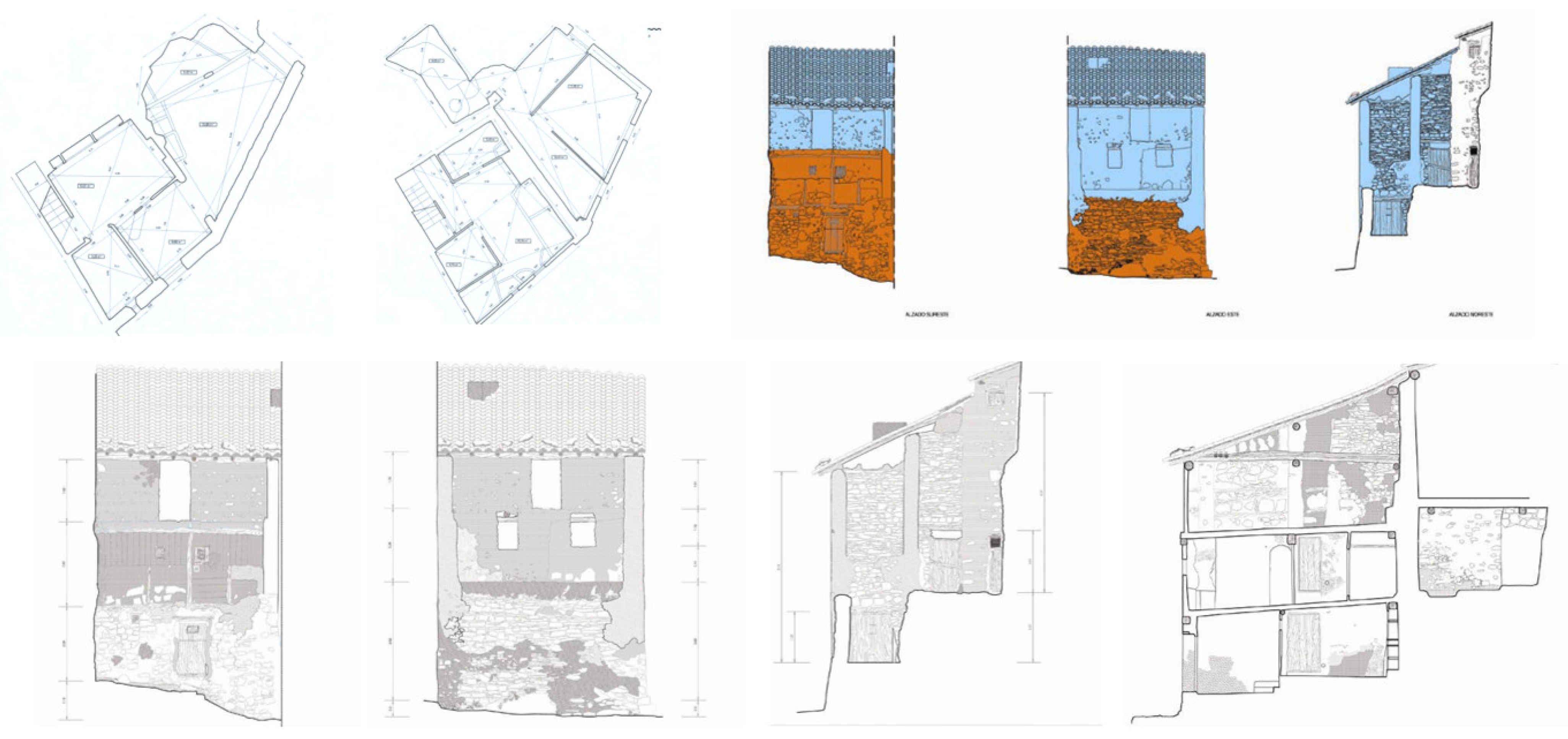
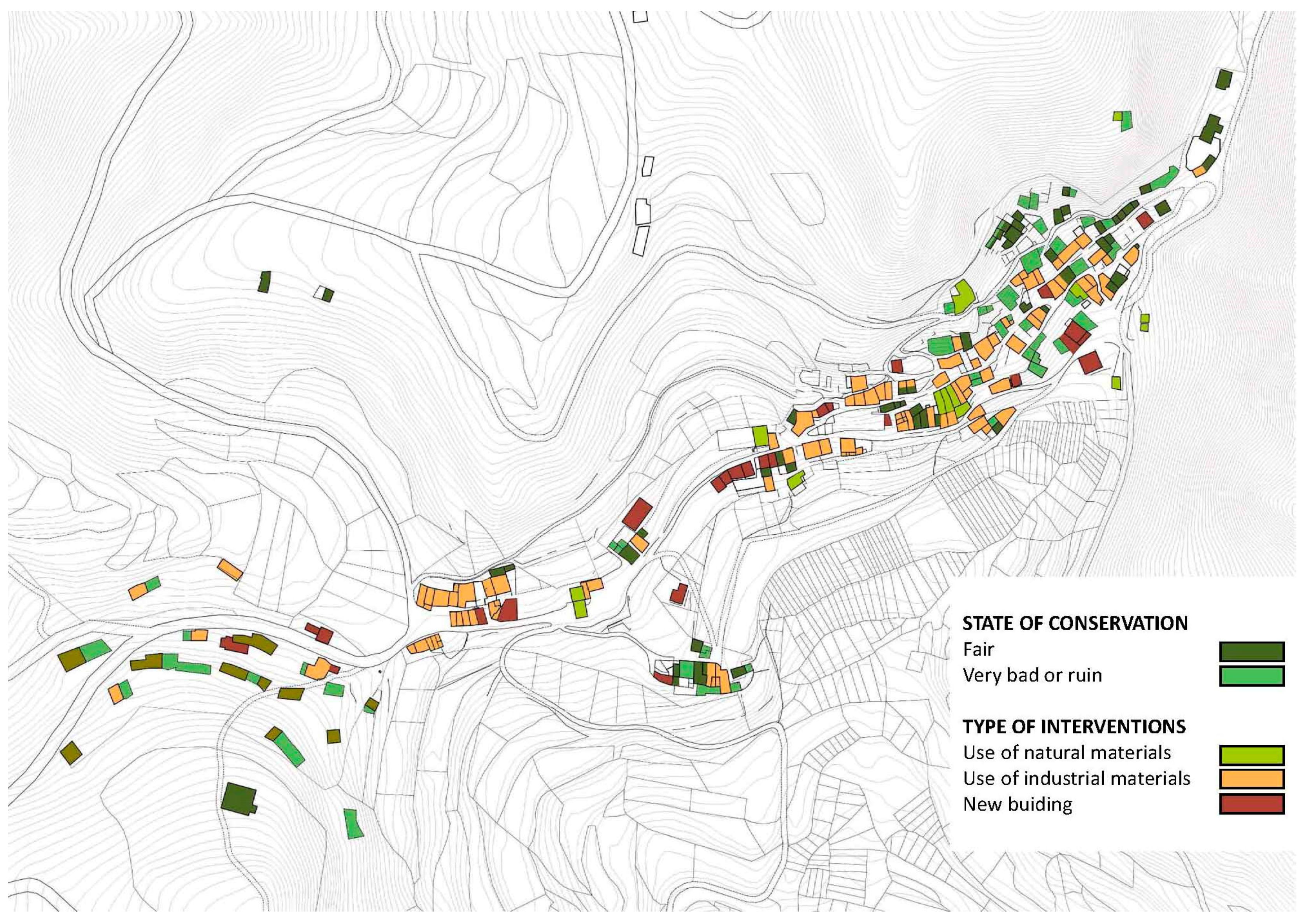



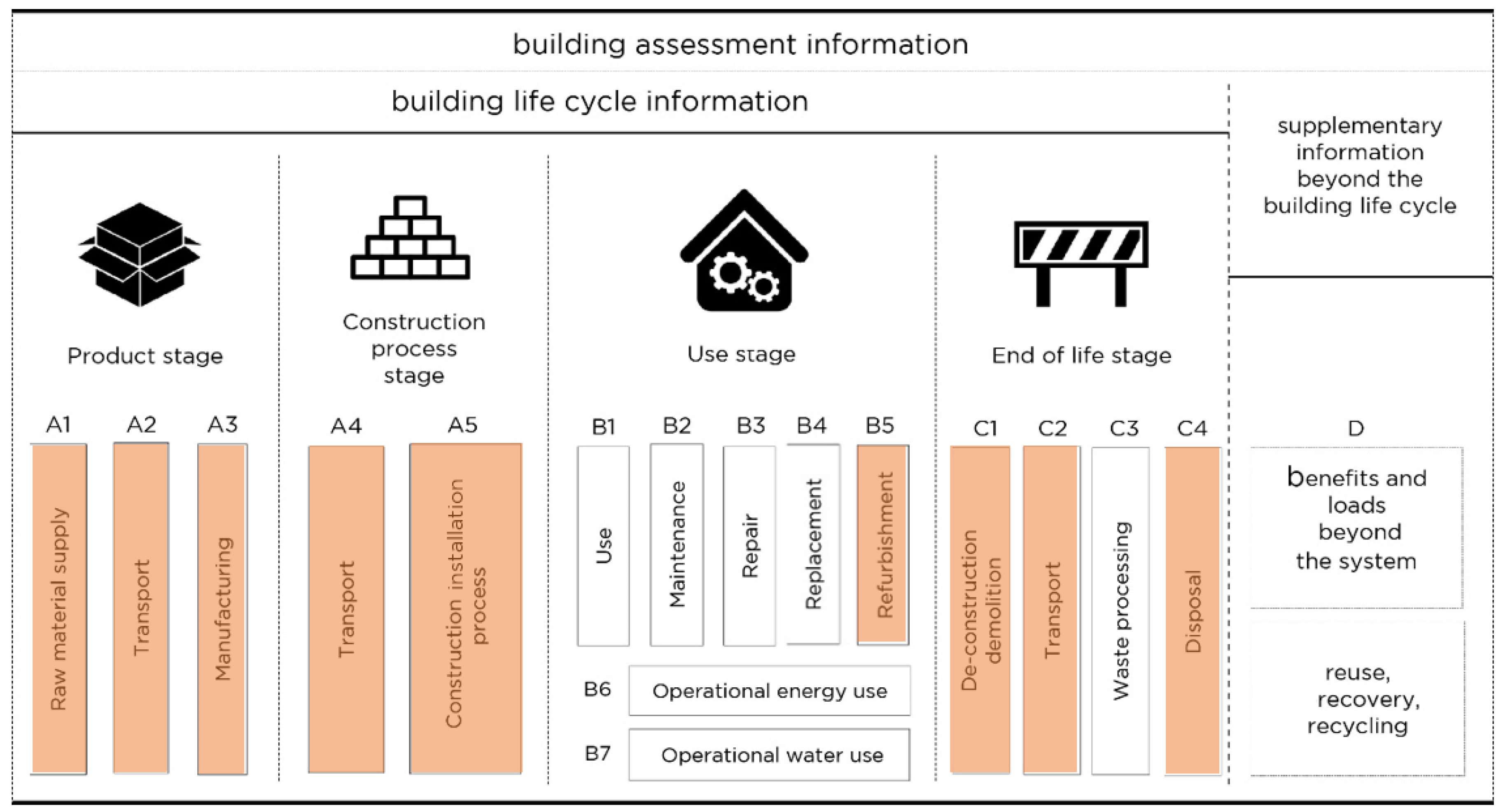
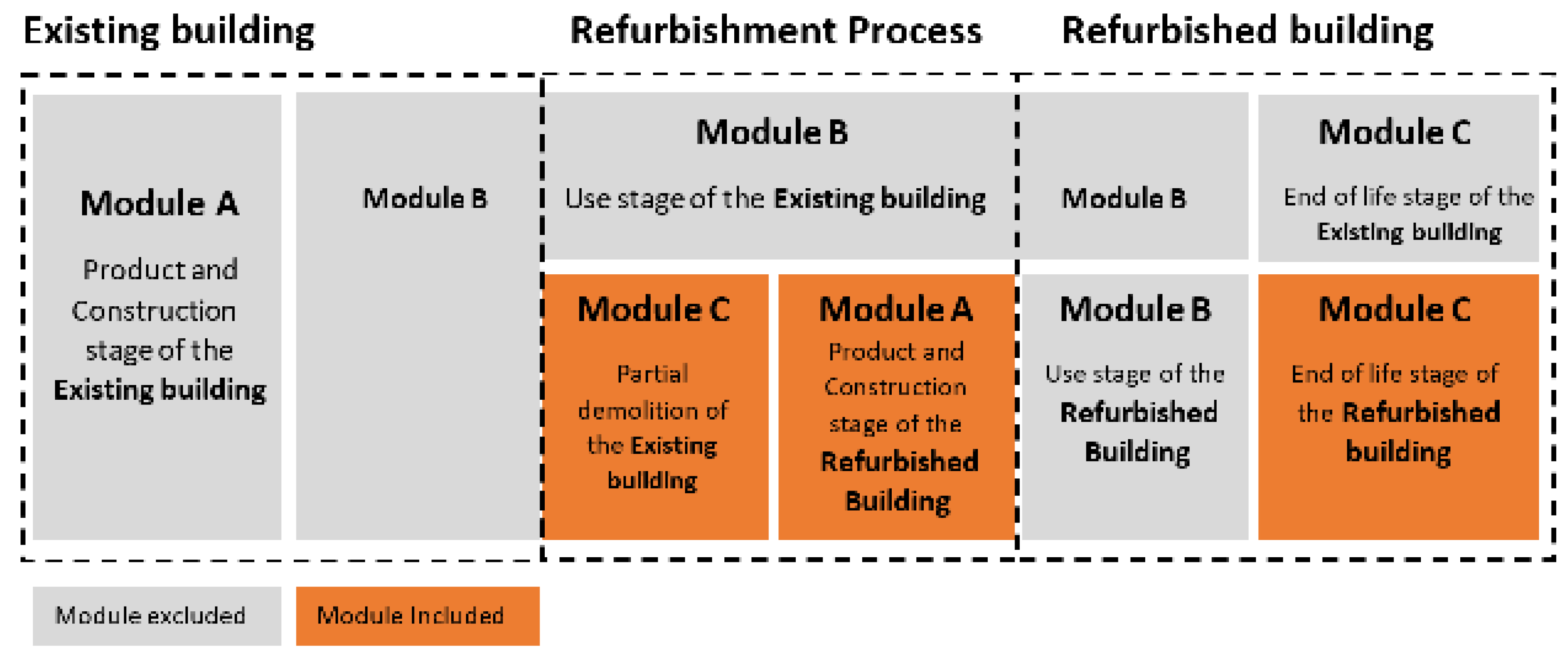

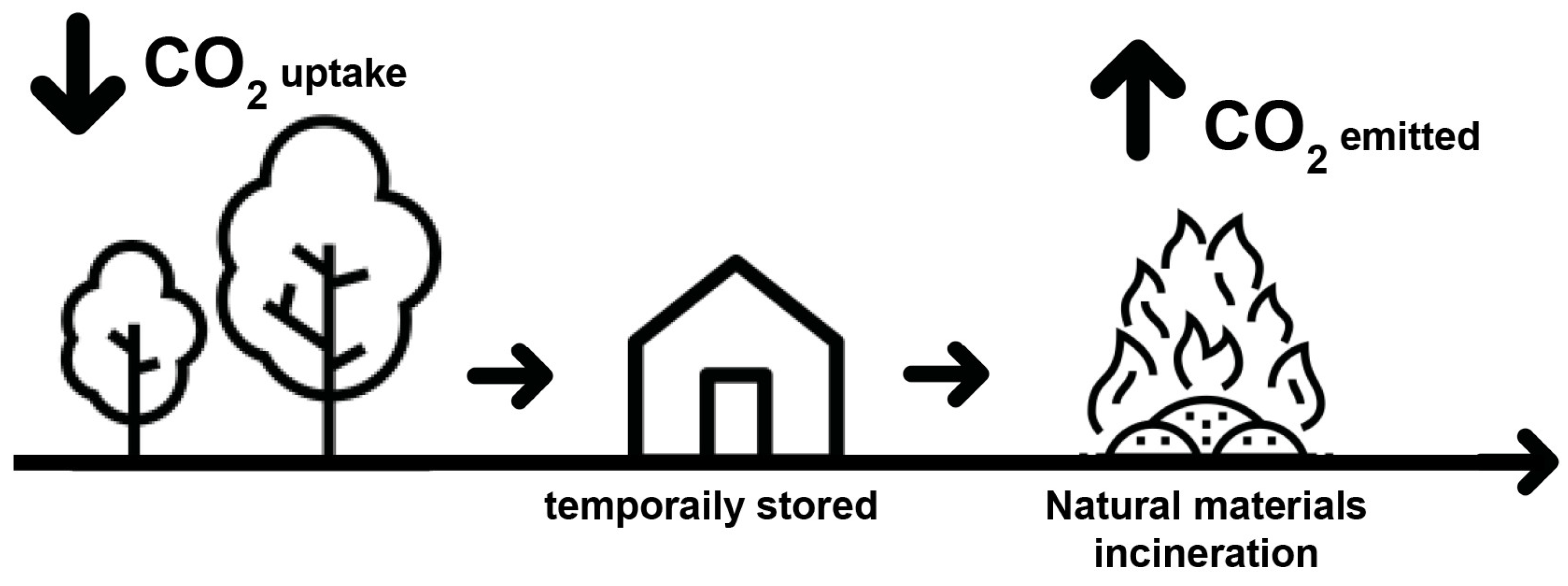

| Option 1 | Options 2 and 3 | ||
|---|---|---|---|
| Listed Material | Adapted Materials to the Ecoinvent v1.2 Dataset [60] | Listed Material | Adapted Materials to the Ecoinvent v1.2 Dataset [60] |
| Stone | Basalt | Aluminium | Aluminium |
| FEL’X | Bitumen | Brick | Brick |
| Brick | Brick | Cement | Cement |
| Cement | Cement | Ceramic Tile | Ceramic tile |
| Ceramic tile | Ceramic tile | Demolition (pre-construction) | Inert material |
| Cork | Cork | Glass | Glass |
| Demolition (pre-construction) | Inert material | Gravel | Gravel |
| Glass | Glass | Gypsum | Gypsum |
| Gravel | Gravel | EPDM | Polyethylene |
| Gypsum | Gypsum | Polystyrene | Polystyrene |
| Limestone | Limestone | Sand | Sand |
| Cane | Log (cane) | Metal | Steel |
| EPDM | Polyethylene | Wood | Wood |
| Polystyrene | Polystyrene | ||
| Sand | Sand | ||
| Metal | Steel | ||
| Straw | Straw | ||
| Wood | Wood | ||
| Rammed earth (composition based on [61], sand, 61.3%, Clay 34.4%, Straw 0.44%, Lime 3.7%) | Straw | ||
| Lime | |||
| Clay | |||
| Sand (wall) | |||
Publisher’s Note: MDPI stays neutral with regard to jurisdictional claims in published maps and institutional affiliations. |
© 2021 by the authors. Licensee MDPI, Basel, Switzerland. This article is an open access article distributed under the terms and conditions of the Creative Commons Attribution (CC BY) license (https://creativecommons.org/licenses/by/4.0/).
Share and Cite
Mileto, C.; Vegas, F.; Llatas, C.; Soust-Verdaguer, B. A Sustainable Approach for the Refurbishment Process of Vernacular Heritage: The Sesga House Case Study (Valencia, Spain). Sustainability 2021, 13, 9800. https://doi.org/10.3390/su13179800
Mileto C, Vegas F, Llatas C, Soust-Verdaguer B. A Sustainable Approach for the Refurbishment Process of Vernacular Heritage: The Sesga House Case Study (Valencia, Spain). Sustainability. 2021; 13(17):9800. https://doi.org/10.3390/su13179800
Chicago/Turabian StyleMileto, Camilla, Fernando Vegas, Carmen Llatas, and Bernardette Soust-Verdaguer. 2021. "A Sustainable Approach for the Refurbishment Process of Vernacular Heritage: The Sesga House Case Study (Valencia, Spain)" Sustainability 13, no. 17: 9800. https://doi.org/10.3390/su13179800
APA StyleMileto, C., Vegas, F., Llatas, C., & Soust-Verdaguer, B. (2021). A Sustainable Approach for the Refurbishment Process of Vernacular Heritage: The Sesga House Case Study (Valencia, Spain). Sustainability, 13(17), 9800. https://doi.org/10.3390/su13179800









